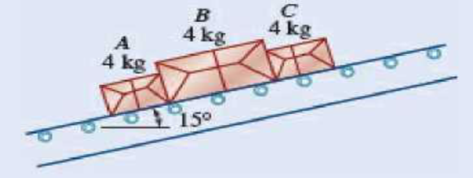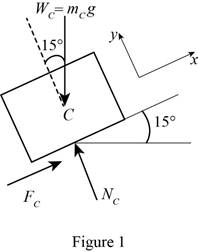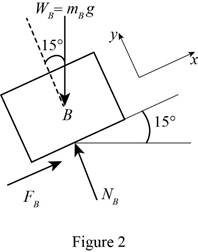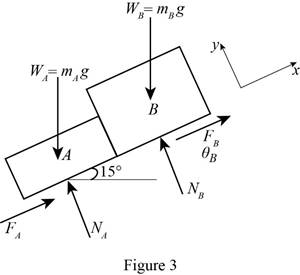
Three 4-kg packages A, B, and C are placed on a conveyor belt that is at rest. Between the belt and both packages A and C, the coefficients of friction are μs = 0.30 and μk = 0.20; between package B and the belt, the coefficients are μs = 0.10 and μk = 0.08. The packages are placed on the belt so that they are in contact with each other and at rest. Determine which, if any, of the packages will move and the friction force acting on each package.

Fig. P8.13
Find whether any of the package moves and the friction force acting on each package.
Answer to Problem 8.13P
The package C will
The friction force in the package C is
The packages A and B will
The friction force in the package B is
The friction force in the package A is
Explanation of Solution
Given information:
The mass of the package A, B, and C is
The static coefficient of friction between packages A and C and the belt is
The static coefficient of friction between package B and belt is
The kinetic coefficient of friction between packages A and C and belt is
The kinetic coefficient of friction between package B and belt is
Calculation:
Consider the acceleration due to gravity as
Consider Block C:
Show the free body diagram of the block C as in Figure 1.

Resolve the vertical component of forces.
Resolve the horizontal component of forces.
Find the maximum friction force
Substitute 0.30 for
The maximum friction force is greater than the friction force.
Therefore, the package C will
Therefore, the friction force in the package C is
Consider Block B:
Show the free body diagram of the block B as in Figure 2.

Resolve the vertical component of forces.
Resolve the horizontal component of forces.
Find the maximum friction force
Substitute 0.10 for
The maximum friction force is less than the friction force.
Therefore, the package B will
Find the friction force in the package B using the kinetic relation.
Substitute 0.08 for
Therefore, the friction force in the package B is
Consider Block A and B together:
Show the free body diagram of the block A and B as in Figure 3.

The normal force in package A is
The normal force in package B is
The friction force in package A is
The friction force in package B is
Find the total normal force in package A and B as follows;
Find the total friction force in package A and B as follows;
The maximum friction force in package A is
The maximum friction force in package B is
Find the maximum friction force
The maximum friction force is less than the friction force.
Therefore, the packages A and B will
Find the friction force in the package A using the kinetic relation.
Substitute 0.20 for
Therefore, the friction force in the package A is
Want to see more full solutions like this?
Chapter 8 Solutions
VECTOR MECHANICS FOR ENGINEERS: STATICS
- No chatgpt plsarrow_forwardA six cylinder petrol engine has a compression ratio of 5:1. The clearance volume of each cylinder is 110CC. It operates on the four-stroke constant volume cycle and the indicated efficiency ratio referred to air standard efficiency is 0.56. At the speed of 2400 rpm. 44000KJ/kg. Determine the consumes 10kg of fuel per hour. The calorific value of fuel average indicated mean effective pressure.arrow_forwardThe members of a truss are connected to the gusset plate as shown in (Figure 1). The forces are concurrent at point O. Take = 90° and T₁ = 7.5 kN. Part A Determine the magnitude of F for equilibrium. Express your answer to three significant figures and include the appropriate units. F= 7.03 Submit ? kN Previous Answers Request Answer × Incorrect; Try Again; 21 attempts remaining ▾ Part B Determine the magnitude of T2 for equilibrium. Express your answer to three significant figures and include the appropriate units. Figure T₂ = 7.03 C T2 |? KN Submit Previous Answers Request Answer × Incorrect; Try Again; 23 attempts remaining Provide Feedbackarrow_forward
- Consider the following acid-base reaction: Fe3+(aq) +3H2O -Fe(OH)3 (s) + 3H* ← A. Using thermodynamics, calculate the equilibrium constant K at 25°C (The AG° of formation of Fe(OH)3(s) is -699 kJ/mol). B. Using the value of K you calculated in part a, if a solution contains 10-4 M Fe3+ and has a pH of 7.5, will Fe(OH)3(s) precipitate? Show all calculations necessary to justify your answer. Note that the reaction as written is for precipitation, not dissolution like Ksp-arrow_forwardA vertical force of F = 3.4 kN is applied to the hook at A as shown in. Set d = 1 m. Part A 3 m 3m 0.75 m 1.5 m. Determine the tension in cable AB for equilibrium. Express your answer to three significant figures and include the appropriate units. FAB= Value Submit Request Answer Part B Units ? Determine the tension in cable AC for equilibrium. Express your answer to three significant figures and include the appropriate units. FAC = Value Submit Request Answer Part C ? Units Determine the tension in cable AD for equilibrium. Express your answer to three significant figures and include the appropriate units.arrow_forwardConsider the heat engine operating at steady state between the two thermal reservoirs shown at the right while producing a net power output of 700 kW. If 1000 kW of heat (Q̇H) is transferred to the heat engine from a thermal reservoir at a temperature of TH = 900 K, and heat is rejected to a thermal reservoir at a temperature of TL = 300 K, is this heat engine possible? Can you answer this question for me and show all of the workarrow_forward
- 1.12 A disk of constant radius r is attached to a telescoping rod that is extending at a constant rate as shown in Fig. P1.12. Both the disk and the rod are rotating at a constant rate. Find the inertial velocity and acceleration of point P at the rim of the disk. ท2 L 0 SS P α e 0 O' êL Fig. P1.12 Rotating disk attached to telescoping rod. 60 LLarrow_forwardTwo different options A and B with brake pads for disc brakes are connected to the rope drum. The diameter of the rope drum is 150 mm. What distance must the pads B be at from the center of rotation to cover the same distance as A?A B- Width 50 mm - Width 60 mm- Evidence center 120mm - Construction power 900 N from rotation center.- Maintains a weight of 200 kgwhen the installation force is 1.4kN (μ is missing from the data)M=μF(Ry-Ri)Right answer R=187 mmarrow_forwardAssume the xy plane is level ground, and that the vertical pole shown in the diagram lies along the z-axis with its base at the origin. If the pole is 5 m tall, and a rope is used to pull on the top of the pole with a force of 400 N as shown, determine the magnitudes of the parallel and perpendicular components of the force vector with respect to the axis of the post i.e. with respect to the z-axis.arrow_forward
- 4-1 Q4: Q5: (20 Marks) Find √48 using False Position Method with three iterations. Hint: the root lies between 3 and 4. (20 Marks)arrow_forwardDetermine the angle between vectors FA and FB that is less than 180 degrees. FA is the vector drawn from the origin to point A (-4, 4, 2) while FB is the vector drawn from the origin to point B (3, 1, -3).arrow_forwardFind the resultant force vector from adding F1, F2 and F3, where … F1 = {-8i+10j-32k} N F2 is 40 N in magnitude with coordinate direction angles α, β, and γ, of 45, 120 and 60 degrees, respectively and F3 is 22 N in magnitude with transverse and azimuth angles of 65 and 40 degrees, respectively Express your final answer as a Cartesian vector as well as a magnitude with angles.arrow_forward
 International Edition---engineering Mechanics: St...Mechanical EngineeringISBN:9781305501607Author:Andrew Pytel And Jaan KiusalaasPublisher:CENGAGE L
International Edition---engineering Mechanics: St...Mechanical EngineeringISBN:9781305501607Author:Andrew Pytel And Jaan KiusalaasPublisher:CENGAGE L
